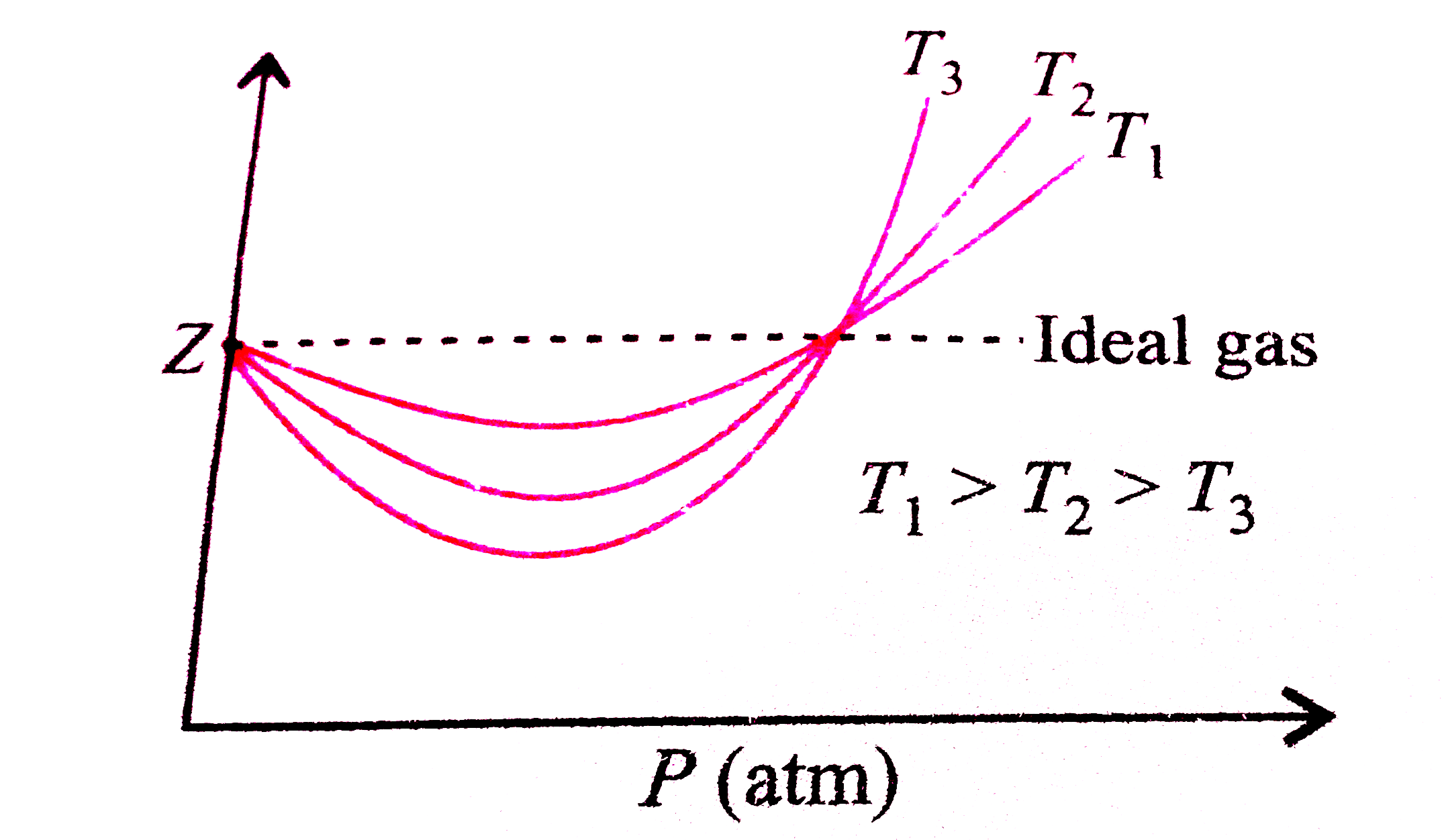What conditions of temperature and pressure are suitable for a real gas to show ideal gas behaviour?
To determine the conditions of temperature and pressure suitable for a real gas to exhibit ideal gas behavior, we can analyze the ideal gas equation and the Van der Waals equation for real gases.
1. Understand the Ideal Gas Law:
The ideal gas law is given by the equation:
PV=nRT
where P is pressure, V is volume, n is the number of moles, R is the ideal gas constant, and T is temperature.
2. Consider the Van der Waals Equation:
For real gases, the Van der Waals equation is:
(P+aV2m)(Vm−b)=RT
where Vm is the molar volume, a and b are constants specific to each gas that account for intermolecular forces and volume occupied by gas molecules, respectively.
3. Identify Conditions for Ideal Behavior:
For a real gas to behave ideally, the effects of the constants a and b must be negligible. This can be achieved under certain conditions:
- High Temperature: At high temperatures, the kinetic energy of the gas molecules increases, which helps overcome intermolecular forces (represented by the constant a). Thus, the term aV2m becomes less significant.
- Low Pressure: At low pressures, the volume of the gas molecules becomes much smaller compared to the total volume of the gas, making the volume occupied by the gas molecules (represented by the constant b) negligible. This means Vm approaches infinity, and the term b can be ignored.
4. Conclusion:
Therefore, the suitable conditions for a real gas to show ideal gas behavior are:
- High Temperature
- Low Pressure
Summary:
In summary, for a real gas to behave like an ideal gas, it should be at high temperatures and low pressures. This minimizes the effects of intermolecular forces and the volume occupied by the gas molecules.
The ideal gas law is given by the equation:
PV=nRT
where P is pressure, V is volume, n is the number of moles, R is the ideal gas constant, and T is temperature.
For real gases, the Van der Waals equation is:
(P+aV2m)(Vm−b)=RT
where Vm is the molar volume, a and b are constants specific to each gas that account for intermolecular forces and volume occupied by gas molecules, respectively.
For a real gas to behave ideally, the effects of the constants a and b must be negligible. This can be achieved under certain conditions:
- High Temperature: At high temperatures, the kinetic energy of the gas molecules increases, which helps overcome intermolecular forces (represented by the constant a). Thus, the term aV2m becomes less significant.
- Low Pressure: At low pressures, the volume of the gas molecules becomes much smaller compared to the total volume of the gas, making the volume occupied by the gas molecules (represented by the constant b) negligible. This means Vm approaches infinity, and the term b can be ignored.
Therefore, the suitable conditions for a real gas to show ideal gas behavior are:
- High Temperature
- Low Pressure
In summary, for a real gas to behave like an ideal gas, it should be at high temperatures and low pressures. This minimizes the effects of intermolecular forces and the volume occupied by the gas molecules.
Topper's Solved these Questions
- STATES OF MATTERBOOK - VMC MODULES ENGLISHCHAPTER - STATES OF MATTEREXERCISE - IN-CHAPTER EXERCISE-A
10 Videos
- STATES OF MATTERBOOK - VMC MODULES ENGLISHCHAPTER - STATES OF MATTEREXERCISE - IN-CHAPTER EXERCISE-B
10 Videos
- STATES OF MATTERBOOK - VMC MODULES ENGLISHCHAPTER - STATES OF MATTEREXERCISE - PRACTICE EXERCISE-8
3 Videos
- STATES OF MATTERBOOK - VMC MODULES ENGLISHCHAPTER - STATES OF MATTEREXERCISE - IMPECCABLE
50 Videos
- STOICHIOMETRY - IBOOK - VMC MODULES ENGLISHCHAPTER - STOICHIOMETRY - IEXERCISE - JEE Advanced (Archive)
31 Videos
Similar Questions
Which gas shows real behaviour?
View SolutionUnder which of the following conditions applied together, a gas deviates most from the ideal behaviour ?
View SolutionA gas will approach ideal behaviour at
View SolutionA gas will approach ideal behaviour at
View SolutionThe pressure exerted by real gas is :-
View SolutionAnswer the following ?
(i) Under the conditions do real gases tend to show ideal gas behavior ?
(ii) What is volume and carbon of Avogadro's number of molecules at N.T.P.?
(iii) Both propane and carbon dioxide diffuse at the same rate under identical conditions of temperature and pressure. Why ?
(iv) If the number of moles of a gas are doubled by keeping the temperature and pressure constant, what will happen to the volume ?
View SolutionAny gas shows maximum deviation from ideal gas behaviour at
View SolutionBoyle's temperature or Boyle point is the temperature at which a real gas starts behaving like an ideal gas over a particular range of pressure. A graph is plotted between compressibility factor Z and pressure P.

What is the deviation of real gas from ideal behaviour in terms of compressibility factor , Z ?
View SolutionWhat is an ideal (or perfect) gas ? Under what condition of pressure and temperature can a gas be assumed as an ideal gas ? Determine the gas constant for one gram molecule of a gas.
View SolutionStatement-1 : At low pressure and high temperature real gas approaches the ideal gas behaviour.
and
Statement-2 : At low prossure and high temperature the molecules are negligible.
View Solution
